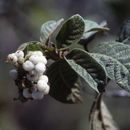pms
nòm ant ël fil


Cordia lutea, known as yellow cordia or in Spanish muyuyo,[2] is a shrubby plant in the borage family (Boraginaceae), native to the Galápagos Islands, mainland Ecuador, Peru, and the Marquesas Islands in Polynesia. Common in the arid lowlands of the Galápagos, its relatively large yellow flowers make it easy to identify.
Cordia lutea grows as a shrub or a small tree, up to 8 m (26 ft) tall. The young branches are hairy. The undivided leaves are arranged alternately, and are 4–10 cm (1.6–3.9 in) long, ovate to round in shape, with very finely toothed margins. The upper side of the leaf is rough in texture but hairless; the lower side bears hairs.
The yellow flowers are arranged in cymes and are sweetly scented. The petals of each flower are fused together to form a trumpet shape, 2–4 cm (0.8–1.6 in) across at the mouth, which has five to eight lobes. Inside the flower there are five to eight stamens. After fertilization, a globular white fruit (a drupe) forms, 8–12 millimetres (0.3–0.5 in) across, containing from one to four seeds. The fruit has a fleshy pulp that is initially slimy when the fruit is opened, but becomes sticky on exposure.[3]
In habitat on the edge of a beach, with Cryptocarpus pyriformis, Santa Fé, Galapágos
Cordia lutea was first described scientifically in 1791 by the French botanist Jean-Baptiste Lamarck,[1] with its origin said to be Peru.[4] The specific epithet lutea means "yellow", more usually a deep yellow.[5] In 1852, the Swedish botanist Nils Johan Andersson collected in the Galápagos Islands,[6] and in 1855 described Varronia flava, now considered to be the same species as Cordia lutea.[7]
In regions such as the Galápagos, where several species of Cordia occur, C. lutea is said to be easy to identify, "due to its showy yellow flowers".[2]
A molecular phylogenetic study in 2005 suggested that Cordia lutea is most closely related to C. dentata, both from the New World, and that these two are the sister of a large clade of Old World species, together forming the Myxa clade within the genus. It is suggested that the origin of the clade was in the New World, from where it was dispersed to Africa and beyond by birds.[8]
Cordia lutea is native to Ecuador, both the western part of the mainland and the Galápagos Islands, Peru, and the Marquesas Islands in Polynesia.[8] It grows in arid regions. In the Galápagos, it is found in the lowlands, often close to the sea.[2]
Cordia lutea, known as yellow cordia or in Spanish muyuyo, is a shrubby plant in the borage family (Boraginaceae), native to the Galápagos Islands, mainland Ecuador, Peru, and the Marquesas Islands in Polynesia. Common in the arid lowlands of the Galápagos, its relatively large yellow flowers make it easy to identify.
Cordia lutea, conocida como cordia amarilla o en español muyuyo,[2] El árbol de Cordia lutea generalmente conocido como Muyuyo, nombre
Cordia lutea crece como arbusto o un árbol pequeño, hasta 8 m de alto. Las ramas jóvenes son peludas. Las hojas no divididas están dispuestas alternadamente, y tienen de 4 a 10 cm de largo, de forma ovalada o redonda, con márgenes muy finos y dentados. El lado superior de la hoja es áspero en textura pero sin pelo, que si están presentes en el lado inferior.
Las flores amarillas se distribuyen en racimo y son dulcemente perfumadas. Los pétalos de cada flor se funden juntos en una forma de trompeta, 2-4 cm a través en la boca, que tiene de cinco a ocho lóbulos. Dentro de la flor hay cinco a ocho estambres. Después de la fertilización, forma (una drupa), de 8–12 milímetros de diámetro que contiene de una a cuatro semillas. La fruta tiene una pulpa carnosa que al exprimirse produce un material viscoso que se vuelve pegajoso al ambiente.[3]
En hábitat en el borde de una playa, con Cryptocarpus pyriformis, Santa Fe, Galapágos
Cordia lutea fue descrita científicamente en 1791 por el botánico francés Jean-Baptiste Lamarck,[1] como originaria de Perú.[4] El epíteto específico lutea significa "amarillo", más normalmente un profundo amarillo.[5] En 1852, el botánico sueco Nils Johan Andersson recogió en las Islas Galápagos,[6] y en 1855 describió Varronia flava, ahora considerada la misma especie de Cordia lutea.[7]
En regiones como las Galápagos, donde hay varias especie de Cordia ocurrir, de dice que C. lutea es fácil de identificar, "debido a sus flores amarillas vistosas".[2]
Un estudio filogenético molecular en 2005 sugiere que Cordia lutea está más estrechamente relacionado con C. dentata, tanto desde el Nuevo Mundo, y que estos dos son emparentadas con un gran clado de especies del Viejo Mundo, formando el clan Myxa dentro del género. Se sugiere que el origen del clado estaba en el Nuevo Mundo, desde donde fue dispersado a África y más allá por las aves.[8]
Cordia lutea es nativa del Ecuador, tanto en la parte occidental de la península y las Islas Galápagos, Perú y las Islas Marquesas, en la Polinesia.[8] crece en regiones áridas. En las Islas Galápagos se encuentra en las tierras bajas, a menudo cerca del mar.[2]
Cordia lutea, conocida como cordia amarilla o en español muyuyo, El árbol de Cordia lutea generalmente conocido como Muyuyo, nombre
Cordia lutea là loài thực vật có hoa trong họ Mồ hôi. Loài này được Lam. mô tả khoa học đầu tiên năm 1792.[1]
Cordia lutea là loài thực vật có hoa trong họ Mồ hôi. Loài này được Lam. mô tả khoa học đầu tiên năm 1792.